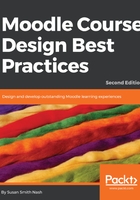
Bloom's taxonomy
As you start to shape your learning outcomes, many teachers and course designers find it very useful to use Bloom's taxonomy as a guide. Benjamin Bloom was an educational psychologist who helped develop a classification scheme for learning objectives that reflects how to show mastery in different skills, knowledge areas, and abilities.
The result—Bloom's taxonomy—is a series of six different categories of cognitive skills, which ascend from the most basic types to the most complex ones.
Revised in 2001, there are six levels of Bloom's taxonomy, which ascend from the lowest to the highest cognitive skills as follows:
- Knowledge/remembering
- Comprehension/understanding
- Application/applying
- Analysis/analyzing
- Evaluation/evaluating
- Synthesis/creating
You can use Bloom's taxonomy to create your learning outcomes using verbs that describe student learning. Bloom's taxonomy can help you take a building block approach to teaching and learning by starting with the least complex cognitive skill category (knowledge/remembering) and then moving up through the levels so that by the end of the course, your students are able to synthesize and create the information. Be sure to keep your learning objectives to six or seven. Too many learning outcomes will complicate your mapping process and result in duplications. The following diagram shows how the skills ascend with complexity:

After you have created the six or seven learning outcomes for your course, keep in mind that you're aiming for outcomes at a variety of different levels. Then, you will need to assemble them in ascending order of complexity. Doing so will help you organize the way you present the material and select your resources and activities. It will also create scaffolding in which your students use the material they've just learned to ascend to the next level.
So, let's apply Bloom's taxonomy to our Tourist Trend course. We've already built the course learning objectives. We've divided the course in units that correspond to the different objectives. Now let's look at how we can go into each topic or unit and write unit-learning objectives that correspond to Bloom's taxonomy.
As you may recall, our first topic is New Definitions of Tourism. So, let's go in and add a resource. In this case, let's add a page. We can give the page a name: Unit Learning Objectives. Then, let's write learning objectives that tie directly to a definition of tourism. Let's start with the lower-level Bloom's Taxonomy level ("remembering") and then ascend to "understanding." This screenshot shows how the page will look:

Now you can probably see where we're going with this. As companions to the Unit Learning Objectives page, we can add a resource that provides instructional material illustrative of each learning objective. We can add an activity that asks the learner to apply the knowledge or concepts. Then, finally, we can add an activity that will also serve as a summative assessment and determine whether or not the learner demonstrated mastery.